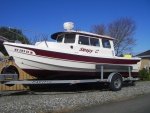thataway
Well-known member
- Joined
- Nov 2, 2003
- Messages
- 21,692
- Reaction score
- 63
- C Dory Year
- 2007
- C Dory Model
- 25 Cruiser
- Hull Identification Number
- DOR25652A707
- Vessel Name
- thataway
The tire manufacturers know far more about their tires than the trailer "builders". The trailer builders are covering their building of trailers against boaters who are going to abuse the trailers. Over inflation will cause abnormal wear patterns. There are plenty of articles about this.
Here is the quote off the Endurance pressure chart:
The tires will go up in pressure as they heat up. The exception to this may be as one goes up in altitude a large amount.
I run temp and pressure sensors on all of the trailer tires (and have been RVs) for a very long time.
Go with what the trailer tire manufactures give as proper inflation.
Here is the quote off the Endurance pressure chart:
LOAD/INFLATION INFORMATION FOR GOODYEAR® ENDURANCE SPECIAL TRAILER (ST) TIRES
TIRE LOAD LIMITS (LBS) AT VARIOUS COLD INFLATION PRESSURE[/u]S (PSI) USED IN NORMAL HIGHWAY SERVICE*
The tires will go up in pressure as they heat up. The exception to this may be as one goes up in altitude a large amount.
I run temp and pressure sensors on all of the trailer tires (and have been RVs) for a very long time.
Go with what the trailer tire manufactures give as proper inflation.

